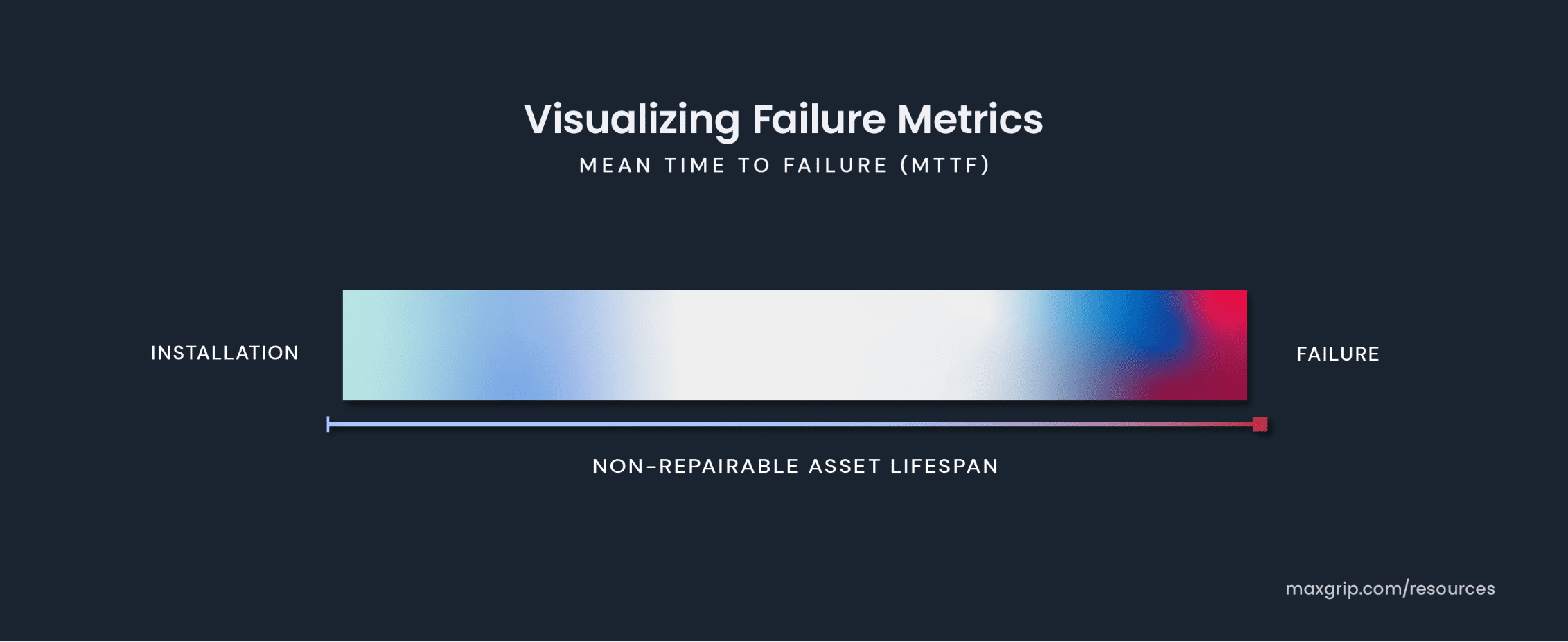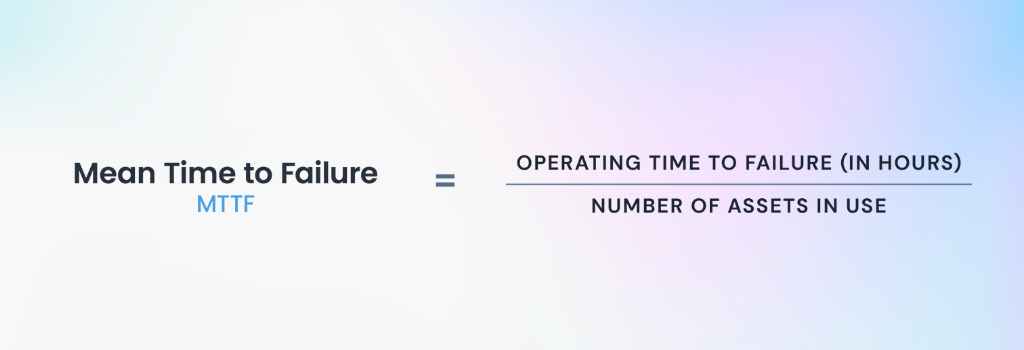One of the key failure metrics used to measure reliability is a Mean Time to Failure, or MTTF. The article below shares the appropriate use cases for MTTF and how this simple measurement can be a powerful tool for driving decision-making on asset replacements and repairs.
Key Takeaways
- Mean Time to Failure (MTTF) measures the average operating time to failure for a non-repairable similar assets or components
- A non-repairable asset is an asset that is typically replaced rather than repaired when it fails
- MTTF = Operating time to failure (in hours) / Number of assets in use
- There is no specific universal benchmark for the MTTF of non-repairable assets. Rather, it is more effective to consider a few factors when deciding whether an MTTF is “good” or not

The role of a maintenance and reliability leader is to continuously find methods to optimally use gathered data to track the progress of maintenance activities and to measure the true reliability of their assets.
In earlier articles we shared how Mean Time to Repair (MTTR) and Mean Time Between Failure (MTBF) is used to measure how long it takes to repair and bring an asset back online. However, an important data piece is measuring how long an asset will last before it fails, which is the exact intention of calculating ‘Mean Time to Failure’.
What is Mean Time to Failure (MTTF)?
Mean Time to Failure (MTTF) is a maintenance metric that measures the average operating time to failure for a non-repairable similar assets or components. Effectively, MTTF measures the reliability of non-repairable assets by looking at similar assets over a period of time and measuring how long they perform until failure.
A non-repairable asset is an asset that is generally replaced rather than repaired when it fails as it would be more cost-effective. A few examples of non-repairable assets are lightbulbs, small HP motors, and fan belts.
How to calculate MTTR
The formula for calculating MTTF as described by the SMRP is as follows:
MTTF = Operating time to failure (in hours) / Number of Assets in Use
Failure = when an asset is no longer able to perform its intended function
Operating time = the timeframe that an asset or component is in operation

What is considered a good MTTF?
There is no specific universal benchmark for the MTTF of non-repairable assets. Rather, it is more effective to consider a few factors when deciding whether an MTTF is “good” or not. Among these factors are the expected lifecycle of the asset, the environmental conditions in which they perform, the quality of the installation, and how it compares to like-assets on the site that share a similar use-case.
Ways to improve the MTTF for your assets
Conduct a failure analysis
Whenever an unexpected failure occurs, it can prove to be valuable to conduct a Root Cause Failure Analysis (RCFA) or a Failure Mode Effects and Criticality Analysis (FMECA) to help understand why an asset is experiencing a and how to prevent premature failures from happening in the future.
FMECA is a common method used to find problems with the design of a product, the manufacturing process, the materials used, or the installation method.
Consider the quality of the replacement parts used
Consider the context of a personal “asset” like your vehicle. Although there are certain replacement parts that are “good enough,” it can sometimes be counterproductive to use a cheaper or inferior replacement just to cut costs. For example, if you live in an urban setting but replace your city tires with all-terrains, you will lose a significant amount of MPGs which can add up to more fuel costs.
Similarly, using quality replacement parts for your assets, specifically OEM parts, will lead to greater reliable because these parts are manufactured to spec for the asset and use the verifiable materials and processes. In general, a quality replacement part is unlikely to fail due to wear or inadequate manufacturing materials.
Download our “MRO Inventory Best Practices Checklist” to make sure you are ready when it is time to replace parts.
Maintain your assets to keep them in good working order
Preventive Maintenance can often be overlooked due to the common misconception that it only applies to large or complex machinery. However, small motors, pumps, valves, fans, heat exchangers, and other pieces of equipment can all be subject to PM. Scheduled maintenance helps to reduce the risk of unplanned downtime, improves efficiency, and decreases costs.
Predictive maintenance is a strategy that uses sensor technology to monitor and predict the health of the asset before it breaks down. These sensors can provide information about the condition of the asset and allow you to take steps to avoid breakdowns. This same predictive technology is used to detect the future failure of a non-repairable asset, which can allow for proper planning for its replacement.
Test new assets on an engineering project
An idea to consider for improving the MTTF of your site is to test a new asset on an engineering project to monitor it and evaluate its true performance and cost-effectiveness.
For example, if your site is considering a new centrifugal pump that is a more expensive replacement, then a new engineering project would be the best testing ground to decide whether it is worth the investment. If the pump is more expensive but lasts longer, then this performance could translate across the entire site.
Why MTTF matters
MTTF is a provides a method to measure reliability since it gives a projected timeline for how long a part or component will last. This will allow for maintenance teams to take preventive maintenance measures that can help extend the life of parts that are critical for production and to inform decisions on its eventual replacement including
Knowing the MTTF of a non-repairable asset is helpful for:
- Informing decisions on whether a replacement part is suitable for the installation’s operating context
- Scheduling maintenance activities
- Inventory planning
- Estimating and evaluating the cost-effectiveness of an engineering project
Although all assets eventually fail, having insights into when it will fail and using these insights to plan and be proactive will lead to more efficient maintenance planning, improved site reliability, and more control of unexpected repairs.
🖥 Watch On-Demand: Foundational CMMS data
📰Continue Reading
- Using Data Insights to Strengthen Your Organization’s Maintenance Strategy
- How business context can influence asset performance benchmarks
- Reliability Centered Maintenance: 8 Steps for Improvement
- Infographic: 5 Benefits of Tracking Equipment Downtime
- How to build a Preventive Maintenance program for long-term success
- Five tips to improve overall equipment effectiveness
Get inspired
MaxGrip consultants Ernstjan Meinen and Justin Satink share four asset management benchmarks and explain with site assessment examples how context influences results.
Middle managers are the driving force for effective change. We list three essential ingredients.
The fishbone diagram is a common tool to identify or prevent a particular event, download a template.




